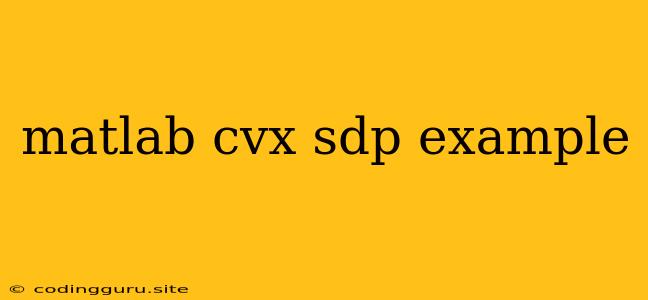MATLAB CVX: A Powerful Tool for Solving Semidefinite Programs
Semidefinite Programming (SDP) is a powerful optimization technique with applications in various fields like control theory, machine learning, and signal processing. MATLAB CVX provides a user-friendly environment to formulate and solve these SDP problems efficiently.
What is Semidefinite Programming (SDP)?
SDP is a type of convex optimization problem where the decision variables are symmetric matrices. It involves minimizing a linear function subject to constraints that require certain matrices to be positive semidefinite. These constraints are expressed as linear matrix inequalities (LMIs).
Why Use CVX for SDP?
CVX is a powerful MATLAB toolbox designed to make formulating and solving convex optimization problems, including SDPs, a breeze. Here are some key benefits of using CVX for SDP:
- Easy Formulation: CVX allows you to express SDP problems in a natural, intuitive way using familiar mathematical notation. You can write down your optimization problem just as you would on paper.
- Solver Integration: CVX seamlessly integrates with various powerful solvers like SeDuMi, SDPT3, and Mosek, which are highly optimized for solving SDPs.
- Automatic Problem Detection: CVX checks the feasibility and convexity of your problem formulation, ensuring that the solver can find a reliable solution.
- User-Friendly Interface: CVX offers a user-friendly syntax, making it easy to understand and implement.
A Simple Example: Maximizing a Quadratic Function
Let's illustrate how CVX can be used to solve a basic SDP problem. Consider the task of maximizing the quadratic function $x^T Q x$ subject to the constraint $x^T x \leq 1$. Here, $Q$ is a symmetric matrix.
% Define the problem data
Q = [1 0; 0 2];
% Create a CVX model
cvx_begin sdp
variable x(2);
maximize(x' * Q * x);
subject to
x' * x <= 1;
cvx_end
% Display the optimal solution
disp(x);
In this code:
cvx_begin sdpdefines the beginning of an SDP problem.variable x(2)declares a 2x1 vectorxas the optimization variable.maximize(x' * Q * x)defines the objective function to be maximized.subject tointroduces the constraint.x' * x <= 1is the constraint that the norm ofxshould be less than or equal to 1.cvx_endmarks the end of the CVX model.
Running this code will give you the optimal solution for x, maximizing the quadratic function within the given constraint.
Beyond Simple Examples: Real-world Applications
CVX and SDPs are employed in various real-world applications, including:
- Control System Design: Designing robust controllers for systems with uncertainties.
- Portfolio Optimization: Finding optimal investment strategies in financial markets.
- Machine Learning: Training support vector machines (SVMs) for classification tasks.
- Signal Processing: Signal recovery and noise reduction.
Tips for Using CVX with SDP
- Understanding Convexity: Make sure your optimization problem is convex. CVX can help you detect non-convexities.
- Choosing the Right Solver: Consider the size and complexity of your problem when selecting a solver. CVX provides a selection of solvers with varying capabilities.
- Understanding the Output: Familiarize yourself with the output of the solver, including the optimal solution, objective value, and any error messages.
Conclusion
MATLAB CVX provides a powerful and user-friendly environment for solving SDP problems. Its intuitive syntax, automatic problem detection, and integration with efficient solvers make it an ideal tool for researchers and engineers working with SDPs in diverse applications. By leveraging CVX and the power of SDP, you can tackle complex optimization problems with ease.
